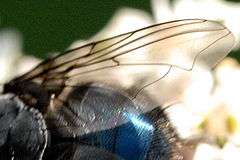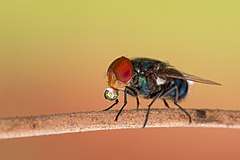Blue bottle fly
| Blue bottle fly | |
|---|---|
| Calliphora vomitoria. Female | |
| Scientific classification | |
| Kingdom: | Animalia |
| Phylum: | Arthropoda |
| Order: | Diptera |
| Family: | Calliphoridae |
| Subfamily: | Calliphorinae |
| Genus: | Calliphora |
| Species: | C. vomitoria |
| Binomial name | |
| Calliphora vomitoria | |
| Synonyms[1][2] | |
| |
The bluebottle fly or bottlebee (Calliphora vomitoria) is a common blow fly belonging to the family Calliphoridae.[3] Calliphora vomitoria is the type species for the genus Calliphora.[2]
Distribution
This species can be found in most areas of the world (in most of Europe, from Alaska to Greenland, south to Mexico and Virginia, Hawaii, southern Africa.[4][5]
Description
.jpg)
Calliphora vomitoria is 10–14 millimetres (0.4–0.6 in) long, slightly larger than a housefly. The head and thorax are dull gray, the back of head has long yellow-orange setae[6][7] and the abdomen is bright metallic blue with black markings. Its body and legs are covered with black bristle-like hair. It has short, clubbed antennae and 4 tarsi per leg. The eyes are red and the wings are transparent. The legs and antennae are black and pink. The chest is bright purple and has spikes to protect themselves against other flies.[8][9]
Similar species include the greenbottle fly, a close relative that can be distinguished by its bright green metallic colouring.
Life cycle
A female blue bottle fly lays her eggs where she feeds, usually in decaying meat, garbage, or feces. Pale whitish larvae, commonly called maggots, soon hatch from the eggs and immediately begin feeding on carcasses of dead animals and on the decomposing matter where they were hatched.[10] After a few days of feeding, they are fully grown. At that time they will crawl away to a dry place where they can burrow into soil or similar matter to pupate into tough brown cocoons. After two or three weeks, the adults emerge to mate, beginning the cycle again. During cold weather, pupae and adults can hibernate until higher temperatures revive them.[9]
Bluebottle fly adults feed on nectar and they are pollinators of flowers, especially with a strong odor often resembling rotting meat. They mainly pollinate skunk cabbage (Symplocarpus foetidus), American pawpaw (Asimina triloba), dead horse arum (Helicodiceros muscivorus), goldenrod and some species of the carrot family.[11]
These insects like to fly in packs in order to detect possible food more efficiently. If one fly detects food, it will disperse a pheromone which will alert the others to the meal.[9]
Human relevance
Its larva, used as fishing bait, is called a maggot, while its pupa, also widely used for bait, is called a caster.
This bluebottle fly can cause human or animal myiasis. Forensic scientists sometimes identify it in the course of their works, particularly in the case of an autopsy of a neglected child.[12]
Gallery
 Adult
Adult Wing
Wing
References
| Wikispecies has information related to Blue bottle fly |
| Wikimedia Commons has media related to Blue bottle fly. |
- ↑ "Calliphora vomitoria". Integrated Taxonomic Information System. Retrieved May 31, 2008.
- 1 2 Kurahshi, Hiromu (May 28, 2007). "109. Family CALLIPHORIDAE". Australasian/Oceanian Diptera Catalog. Hawaii Biological Survey. Retrieved May 31, 2008.
- ↑ BioLib
- ↑ Fauna europaea
- ↑ Calalogue of life
- ↑ Terry Whitworth. Keys to genera and species of blow flies (Diptera: Calliphoridae) of America north of Mexico. Proceedings of The Entomological Society of Washington. 108 (3), s. 689-725, 2006.
- ↑ Krzysztof Szpila: Key for identification of European and Mediterranean blowflies (Diptera, Calliphoridae) of forensic importance. Adult flies
- ↑ Jean-Henri Fabre, 1907 - La mouche verte et violette
- 1 2 3 Michael Chinery, Insectes de France et d'Europe occidentale, Paris, Flammarion, 2012, ( ISBN 978-2-0812-8823-2), p. 214-215
- ↑ Progressive Pest Control
- ↑ Pollinator in Encyclopedia of life National Biological Information Infrastructure (NBII)
- ↑ Benecke M, Lessig R, « Child neglect and forensic entomology », Forensic Sci Int, vol. 120, no 1-2, 2001, p. 155-9.